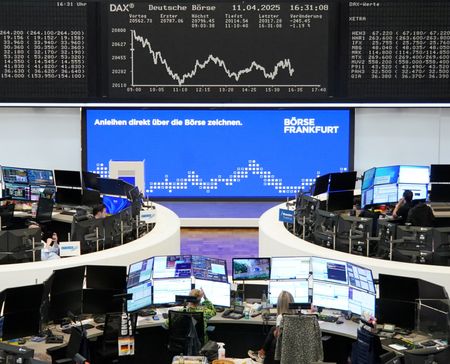(Reuters) – A look at the day ahead in European and global markets from Wayne Cole
So the “reciprocal” tariffs are off smartphones and some electronics, but maybe only for a while as they could get their own special tariff once the White House has completed a study of the global supply chain. Or something.
Indeed, Trump on Sunday told reporters tariffs on semiconductors would be announced over the next week and a decision on phones made “soon”.
Essentially more of the same chaos. How anyone running a company can decide on long-term investments in such conditions is a mystery, which has limited the boost to Wall Street futures for the moment. The S&P 500 was up around 0.8% and the Nasdaq 1.2%, though you would have to assume Apple shares, at least, will benefit in the near term.
European stock futures have actually performed better, perhaps on speculation that President Trump will blink on other levies, too. Or it could be investors are buying Europe now that U.S. exceptionalism and “exorbitant privilege” – the dollar’s status as the world’s reserve currency – are under such threat.
The dollar is certainly feeling unloved, falling back under 143.00 yen and extending last week’s 5% slide on the Swiss franc. The euro is knocking on $1.1400 again and even the high-beta Aussie and kiwi are up, a sure sign the dollar’s safe-haven status is in jeopardy.
Apparently, Japanese officials are gearing up for trade negotiations with the United States that will likely touch on currency policy, with some officials privately bracing for Washington to call on Tokyo to prop up the yen.
Should the White House actively start talking the dollar down, it will spook those offshore investors with unhedged positions in U.S. assets – which is most of them.
At least Treasuries are steadier, though they show little sign of reversing last week’s astonishing 50-basis-point jump in longer-term yields. If sustained, that’s a material tightening in financial conditions and a deadweight for the housing market, adding another reason for the Fed to ease even if inflation is heading higher.
It will be interesting to see if the New York Fed survey of inflation expectations due later on Monday shows the same kind of spike seen in the University of Michigan numbers. Retail sales data for March on Wednesday could be strong as consumers rushed to buy autos and other goods before the tariffs go into effect.
Fed Chair Powell also has a chance to provide his outlook on Wednesday at the Economic Club of Chicago, where the Q&A should be lively. Markets imply a 20% chance of a May rate cut, rising to almost 80% for June. Some 80 basis points of easing are priced in for the year, though that was up around 130 basis points this time last week.
Key developments that could influence markets on Monday:
– NY Fed inflation expectations survey
– Fed speakers include Waller, Barkin, Harker and Bostic
(By Wayne Cole; Editing by Edmund Klamann)










